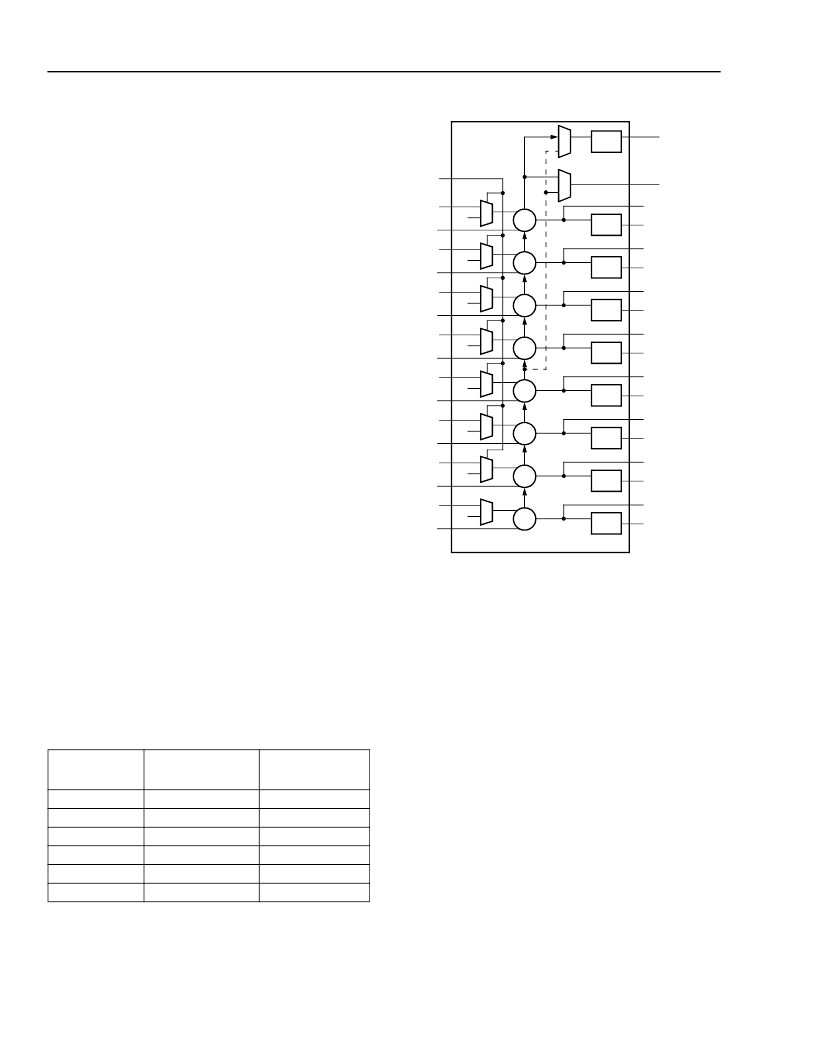- 您現(xiàn)在的位置:買賣IC網(wǎng) > PDF目錄384797 > OR4E10 (Lineage Power) Field-Programmable Gate Arrays(現(xiàn)場(chǎng)可編程門陣列) PDF資料下載
參數(shù)資料
| 型號(hào): | OR4E10 |
| 廠商: | Lineage Power |
| 英文描述: | Field-Programmable Gate Arrays(現(xiàn)場(chǎng)可編程門陣列) |
| 中文描述: | 現(xiàn)場(chǎng)可編程門陣列(現(xiàn)場(chǎng)可編程門陣列) |
| 文件頁(yè)數(shù): | 18/132頁(yè) |
| 文件大?。?/td> | 2667K |
| 代理商: | OR4E10 |
第1頁(yè)第2頁(yè)第3頁(yè)第4頁(yè)第5頁(yè)第6頁(yè)第7頁(yè)第8頁(yè)第9頁(yè)第10頁(yè)第11頁(yè)第12頁(yè)第13頁(yè)第14頁(yè)第15頁(yè)第16頁(yè)第17頁(yè)當(dāng)前第18頁(yè)第19頁(yè)第20頁(yè)第21頁(yè)第22頁(yè)第23頁(yè)第24頁(yè)第25頁(yè)第26頁(yè)第27頁(yè)第28頁(yè)第29頁(yè)第30頁(yè)第31頁(yè)第32頁(yè)第33頁(yè)第34頁(yè)第35頁(yè)第36頁(yè)第37頁(yè)第38頁(yè)第39頁(yè)第40頁(yè)第41頁(yè)第42頁(yè)第43頁(yè)第44頁(yè)第45頁(yè)第46頁(yè)第47頁(yè)第48頁(yè)第49頁(yè)第50頁(yè)第51頁(yè)第52頁(yè)第53頁(yè)第54頁(yè)第55頁(yè)第56頁(yè)第57頁(yè)第58頁(yè)第59頁(yè)第60頁(yè)第61頁(yè)第62頁(yè)第63頁(yè)第64頁(yè)第65頁(yè)第66頁(yè)第67頁(yè)第68頁(yè)第69頁(yè)第70頁(yè)第71頁(yè)第72頁(yè)第73頁(yè)第74頁(yè)第75頁(yè)第76頁(yè)第77頁(yè)第78頁(yè)第79頁(yè)第80頁(yè)第81頁(yè)第82頁(yè)第83頁(yè)第84頁(yè)第85頁(yè)第86頁(yè)第87頁(yè)第88頁(yè)第89頁(yè)第90頁(yè)第91頁(yè)第92頁(yè)第93頁(yè)第94頁(yè)第95頁(yè)第96頁(yè)第97頁(yè)第98頁(yè)第99頁(yè)第100頁(yè)第101頁(yè)第102頁(yè)第103頁(yè)第104頁(yè)第105頁(yè)第106頁(yè)第107頁(yè)第108頁(yè)第109頁(yè)第110頁(yè)第111頁(yè)第112頁(yè)第113頁(yè)第114頁(yè)第115頁(yè)第116頁(yè)第117頁(yè)第118頁(yè)第119頁(yè)第120頁(yè)第121頁(yè)第122頁(yè)第123頁(yè)第124頁(yè)第125頁(yè)第126頁(yè)第127頁(yè)第128頁(yè)第129頁(yè)第130頁(yè)第131頁(yè)第132頁(yè)

18
Lucent Technologies Inc.
Preliminary Data Sheet
August 2000
ORCA Series 4 FPGAs
Programmable Logic Cells
(continued)
In the third submode,
multiplier submode
, a single
PFU can affect an 8x1 bit (4x1 for half-ripple mode)
multiply and sum with a partial product (see Figure 11).
The multiplier bit is input at F5[A:C], respectively per
nibble, and the multiplicand bits are input at K
Z
[1],
where K
7
[1] is the most significant bit (MSB). K
Z
[0] con-
tains the partial product (or other input to be summed)
from a previous stage. If F5[A:C] is logical 1, the multi-
plicand is added to the partial product. If F5[A:C] is log-
ical 0, 0 is added to the partial product, which is the
same as passing the partial product. CIN/FCIN can
bring the carry-in from the less significant PFUs if the
multiplicand is wider than 8 bits, and COUT/FCOUT
holds any carry-out from the multiplication, which may
then be used as part of the product or routed to another
PFU in multiplier mode for multiplicand width expan-
sion.
Ripple mode’s fourth submode features
equality
comparators
. The functions that are explicitly available
are A
≥
B, A
≠
B, and A
≤
B, where the value for A is
input on K
Z
[0], and the value for B is input on K
Z
[1]. A
value of 1 on the carry-out signals valid argument. For
example, a carry-out equal to 1 in AB submode indi-
cates that the value on K
Z
[0] is greater than or equal to
the value on K
Z
[1]. Conversely, the functions A
≤
B,
A + B, and A > B are available using the same functions
but with a 0 output expected. For example, A
>
B with a
0 output indicates A
≤
B. Table 5 shows each function
and the output expected.
If larger than 8 bits, the carry-out
signal can be cas-
caded using fast-carry logic to the carry-in of any adja-
cent PFU. The use of this submode could be shown
using Figure 9, except that the CIN/FCIN input for the
least significant PFU is controlled via configuration.
Table 5. Ripple Mode Equality Comparator
Functions and Outputs
5-5757(F)
Key: C = configuration data.
Note: F5[A:C] shorted together.
Figure 11. Multiplier Submode
Equality
Function
A
≥
B
A
≤
B
A
≠
B
A < B
A > B
A = B
ORCA Foundry
Submode
A
≥
B
A
≤
B
A
≠
B
A > B
A < B
A
≠
B
True, if
Carry-Out Is:
1
1
1
0
0
0
K7[1]
K7[0]
+
D
Q
C
C
D
Q
1
0
0
K7
F5[A:C]
K4[1]
K4[0]
+
D
Q
1
0
0
K4
K3[1]
K3[0]
+
D
Q
1
0
0
K3
K2[1]
K2[0]
+
D
Q
1
0
0
K2
K1[1]
K1[0]
+
D
Q
1
0
0
K1
K6[1]
K6[0]
+
D
Q
1
0
0
K6
K5[1]
K5[0]
+
D
Q
1
0
0
K5
K0[1]
K0[0]
+
D
Q
1
0
0
K0
Q0
F0
Q1
F1
Q2
F2
Q3
F3
Q4
F4
Q5
F5
Q6
F6
Q7
F7
COUT
REGCOUT
相關(guān)PDF資料 |
PDF描述 |
|---|---|
| OR4E14 | Field-Programmable Gate Arrays(現(xiàn)場(chǎng)可編程門陣列) |
| OR4E2 | Field-Programmable Gate Arrays(現(xiàn)場(chǎng)可編程門陣列) |
| OR4E4 | Field-Programmable Gate Arrays(現(xiàn)場(chǎng)可編程門陣列) |
| OR4E6 | Field-Programmable Gate Arrays(現(xiàn)場(chǎng)可編程門陣列) |
| ORT4622 | Field-Programmable System Chip (FPSC) Four Channel x 622 Mbits/s Backplane Transceiver(現(xiàn)場(chǎng)可編程系統(tǒng)芯片(四通道x 622 M位/秒背板收發(fā)器)) |
相關(guān)代理商/技術(shù)參數(shù) |
參數(shù)描述 |
|---|---|
| OR4E14 | 制造商:未知廠家 制造商全稱:未知廠家 功能描述:Field-Programmable Gate Arrays |
| OR4E2 | 制造商:AGERE 制造商全稱:AGERE 功能描述:Field-Programmable Gate Arrays |
| OR4E2-1BA256 | 制造商:未知廠家 制造商全稱:未知廠家 功能描述:FPGA |
| OR4E2-1BA352 | 制造商:未知廠家 制造商全稱:未知廠家 功能描述:FPGA |
| OR4E2-1BA416 | 制造商:未知廠家 制造商全稱:未知廠家 功能描述:FPGA |
發(fā)布緊急采購(gòu),3分鐘左右您將得到回復(fù)。